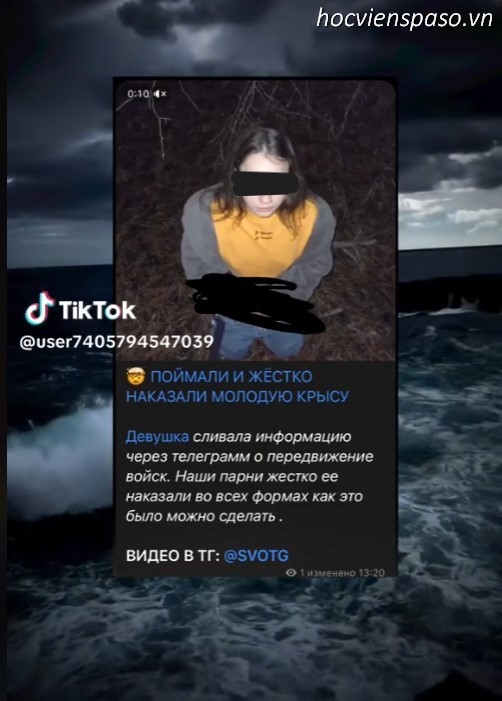Natasha Gavri Medusa Ukraine original Video: Unraveling the Enigma
Discover the viral and mysterious “Natasha Gavri Medusa Ukraine original Video” that has captivated the digital world, leaving everyone questioning its motives and content. Join us as we explore its impact on society, authenticity debates, and reactions on social media, highlighting the importance of critical thinking in the age of viral content. Follow hocvienspaso.vn for more!

I. The Content of the Natasha Gavri Medusa Ukraine Original Video
The Natasha Gavri Medusa Ukraine Original Video depicts a disturbing scene featuring a Ukrainian girl seemingly laughing at an injured victim. The video’s release triggered intense debate and speculation, raising questions about morality, arguments, and their potential to incite violence. While its authenticity remains in question, the video’s wide dissemination raises concerns about social media’s power to spread misinformation and influence public perception.

The disturbing nature of the video goes beyond its content, shedding light on the dangers of online arguments and the need for responsible content regulation. The impact of the video on public opinion and international relations emphasizes the importance of transparency and accountability in social media platforms.
However, there have been conflicting opinions about the girl’s actions, sparking debates about sensitivity and empathy in online content. The incident has prompted calls for greater caution in sharing sensitive material that can harm communities and religions.
As we navigate the enigma surrounding the Natasha Gavri Medusa Video, it becomes clear that critical thinking and fact-checking are crucial in an era of rapid information circulation. The video serves as a cautionary tale about the power and responsibility associated with online content creation and consumption.
@user7405794547039
II. Authenticity and Misinformation of the Natasha Gavri Medusa Video
The authenticity of the Natasha Gavri Medusa Video has been a subject of ongoing debate and speculation. While the video has garnered widespread attention and reactions on social media, its true origin and veracity remain uncertain. Some have questioned whether the footage is genuine, suggesting that it might be an attempt to deceive or manipulate public opinion.
The rapid dissemination of the video on social media platforms has also raised concerns about misinformation and its potential impact on public perception. In the age of viral content, information can spread quickly, irrespective of its accuracy. This poses significant risks as false or misleading information can influence public discourse and even international relations.
The incident serves as a reminder of the importance of verifying information before accepting it as true and the need for critical thinking when encountering viral content. Responsible sharing and fact-checking are essential to combat the spread of misinformation and protect individuals and communities from the potential harm caused by deceptive content.
As the Natasha Gavri Medusa Video continues to stir discussions and reactions, it highlights the significance of transparency and accountability in online platforms. Social media companies play a crucial role in addressing misinformation, and there are growing calls for them to implement stronger content regulation policies to prevent the spread of deceptive material. By fostering a culture of responsible content creation and consumption, we can mitigate the risks of misinformation and preserve the integrity of online information-sharing.
III. Reactions on Social Media to Natasha Gavri Medusa Video
Reactions to the Natasha Gavri Medusa Video have been varied and intense on social media platforms. The video’s disturbing content and the controversy surrounding its authenticity have sparked heated debates and emotional responses from users worldwide.
Many people expressed outrage and condemnation at the actions depicted in the video. They found the behavior of the Ukrainian girl laughing at the injured victim to be deeply insensitive and lacking in empathy. Some questioned the motives of the person who recorded and shared the video, raising concerns about the ethics of such actions.
In contrast, there were also divergent opinions regarding the incident. Some users defended the girl’s actions, arguing that it could have been taken out of context or manipulated. This led to further arguments and clashes between opposing viewpoints, illustrating the polarizing effect of viral content on social media.
Additionally, the widespread dissemination of the video has sparked discussions about the responsibility of social media platforms in regulating sensitive and potentially harmful content. Many users voiced their frustration with the platforms’ handling of such content, calling for stricter policies to prevent the spread of graphic or abusive material.
The incident also shed light on the need for users to exercise caution and empathy when sharing content online. Many recognized the potential harm that can arise from disseminating sensitive or disturbing material without considering the impact it may have on others.
Overall, the reactions on social media to the Natasha Gavri Medusa Video highlight the power and influence that viral content can wield in shaping public discourse and emotions. The incident serves as a poignant reminder of the collective responsibility to foster a respectful and responsible online community, promoting critical thinking, and engaging in constructive conversations rather than perpetuating harmful or misleading content.
IV. Conclusion
In conclusion, the “Natasha Gavri Medusa Video” remains an enigmatic and divisive phenomenon. Its authenticity and impact on social media raise concerns about misinformation and responsible content sharing. The incident underscores the need for empathy and critical thinking in online interactions. It serves as a reminder of the collective responsibility to foster a respectful and informed digital community.







